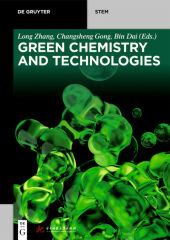 Neuerscheinungen 2018Stand: 2020-02-01 |
Schnellsuche
ISBN/Stichwort/Autor
|
Herderstraße 10
10625 Berlin
Tel.: 030 315 714 16
Fax 030 315 714 14
info@buchspektrum.de |

Dai Bin, Changsheng Gong, Huazhong University of Science, Long Zhang
(Beteiligte)
Green Chemistry and Technologies
Herausgegeben von Zhang, Long; Gong, Changsheng; Bin, Dai; Mitarbeit: Huazhong University of Science and
2018. XIX, 515 S. 145 b/w and 0 col. ill., 28 b/w tbl. 240 mm
Verlag/Jahr: DE GRUYTER 2018
ISBN: 3-11-047861-7 (3110478617)
Neue ISBN: 978-3-11-047861-7 (9783110478617)
Preis und Lieferzeit: Bitte klicken
The book gives a systematic introduction to green chemistry principles and technologies in inorganic and organic chemistry, polymer sciences and pharmaceutical industry. It also discusses the use of biomass and marine resources for synthesis as well as renewable energy utilization and the concepts and evaluation of recycling economy and eco-industrial parks.
Table of Content:
Chapter 1 Introduction: research, definition, latest development
Chapter 2 Theoretical background for green chemistry
2.1 Prevent pollutions before they happen
2.2 Molecular economics
2.3 Green chemistry synthesis
2.4 Environmental friendly chemicals
2.5 Environmental friendly solvents and auxiliary chemicals
2.6 Energy saving
2.7 Synthesis with renewable resources
2.8 Derivatization reduction
2.9 Catalysis
2.10 Degradable chemicals
2.11 Field study for pollutions
2.12 Workflow for incident
Excises
References
Chapter 3 Green chemistry in inorganic chemistry
3.1 Hydrothermal synthesis
3.2 Sol-gel method
3.3 Local chemical reaction
3.4 Low heating solid state reaction
3.5 Rheological phase reaction
3.6 Precursor route
3.7 Flux melting technique
3.8 Chemical Vapor Deposition
3.9 Polymer template method
Excises
References
Chapter 4 Green synthesis
4.1 High efficiency catalysis in organic synthesis
4.2 bio catalysis in organic synthesis
4.3 Asymmetric Catalysis synthesis
4.4 Fluorous biphase system in organic synthesis
4.5 Phase transfer catalyst
4.6 Combinatorial chemical synthesis
4.7 Electro-organic synthesis
Excises
References
Chapter 5 Polymer in green chemistry
5.1 Polymerization with water as dispersion medium
5.2 Polymerization in ionic liquid
5.3 Polymerization in supercritical fluid
5.4 Low VOC residue in water-borne polyurethane synthesis
5.5 Radiation crosslinking
5.6 Plasma polymerization
5.7 Enzyme - Catalyzed polymerization
Excises
References
Chapter 6 Green technologies in fine chemical industry
6.1 Green technologies in pharmaceutical industry
6.2 Green technologies in pesticide production
6.3 Green technologies in function materials
6.4 Green technologies in electrochemistry
Excises
References
Chapter 7 Green technologies in intermediate product synthesis
7.1 Introduction
7.2 Green synthesis for important intermediates
7.3 Green synthesis for typical products
Chapter 8 Use CO2 as resources and cut down emission
8.1 Global CO2 emission
8.2 CO2 separation and fixation
8.3 CO2 conversion
8.4 Using CO2 as recourse and case studies
8.5 Reduce emission for CO2
Excises
References
Chapter 9 Biomass utilization
9.1 Introduction
9.2 Biomass classification and analytical methods
9.3 Biomass conversion
9.4 Biomass separation and processes
9.5 Biomass in chemical industry - use biomass to produce different kinds of chemicals
9.6 Natural lipid conversion
Excises
References
Chapter 10 Green chemistry and technologies in marine resources utilization
10.1 Marine resources and development
10.2 Extract food addictives from marine resources
10.3 Extract drugs from marine resources
10.4 Extract trace element from marine resources
10.5 Convert sea water to fresh water
10.6 Marine resources exploration
Excises
References
Chapter 11 Green chemistry and technologies in energy industry
11.1 Green chemical technologies in fossil fuel
11.2 Biofuel
11.3 Renewable resources
11.4 Renewable resources and sustainable development
Excises
References
Chapter 12 Recycling economy and eco-industrial park
12.1 Theoretical foundations for eco-industrial park
12.2 Recycling economy
12.3 Eco-industrial park
12.4 Eco-industrial park and social development
Excises
References
Chapter 13 Enhancement technologies in chemical processes
13.1 An overview
13.2 Multifunctional reaction technique
13.3 Separation-coupling technologies
13.4 Microchemical technology
13.5 Hydrodynamic cavitation
13.6 High gravity technology
13.7 Supercritical fluid technology
13.8 Pulse combustion drying technology
13.9 Enhancement technologies based on energy field
13.10 Enhancement equipment
Excises
References
Chapter 14 Green chemistry evaluation
14.1 Evaluation principles
14.2 Life cycle evaluation
14.3 Evaluation in green chemical engineering
14.4 Industrialization of green chemistry technologies
Excises
References


